
The Impact of COVID-19 on Insurance Ratings

Gurdip Dhami
25 years: Treasury & ratings
In this video Gurdip outlines how the insurance rating criteria have been used by the rating agencies to assess the impact of COVID-19 on insurance companies.
In this video Gurdip outlines how the insurance rating criteria have been used by the rating agencies to assess the impact of COVID-19 on insurance companies.

The Impact of COVID-19 on Insurance Ratings
17 mins 1 sec
In addition to the tragic loss of life, there have been negative economic and financial consequences of Covid-19 on many individuals, companies and governments throughout the world. Since the start of the pandemic, the credit profiles of a large number of entities have deteriorated as a result of revenue declines due to lock-downs, declines in financial markets, especially at the start of the pandemic, and low oil prices. The insurance rating criteria have been used by the rating agencies to assess the impact of Covid-19 on insurance companies.
Key learning objectives:
Understand how the rating criteria and issuer rating reports can be used to understand the approach of the rating agencies to Covid-19.
Understand how COVID-19 has affected the insurance companies
Understand how rating agencies have responded to COVID-19
Identify the most impacted credit rating factors due to Covid-19
What actions have been taken by rating agencies in response to COVID-19?
The rating agencies have taken a large number of negative rating actions across various industry sectors. Negative rating actions are rating downgrades, credit watch negatives, or changes in outlooks from stable to negative and positive to stable.
- Since March 2020 S&P has taken negative rating actions on approximately 2000 companies due to Covid-19 and low oil prices
- In September 2020, S&P stated that it took negative rating actions across 41% of all its rated credits but it only took negative action on about 10% of its rated insurers
- Most of Moody’s and Fitch rated insurance companies have had no change in their ratings as a result of Covid-19 either. Fitch affirmed 67% of its rated insurers and where it did take negative action, these were changes in outlook not downgrades
How has Covid-19 affected the insurance companies?
- Capital adequacy is reduced by falls in equity markets, increased credit spreads, lower ratings of corporate bond holdings and lower interest rates
- Profitability is reduced by increased insurance claims due to event cancellation and business interruption
- Lower economic activity reduces premiums from business customers, and stock market volatility reduces the number of retail buyers of investment products
- Profitability falls as investment income reduces due to lower interest rates although these may be offset by MTM gains on investments
- Pay-outs from Life insurance policies increase due to Covid-19 related deaths which leads to increased costs and reduced profitability
How have rating agencies responded to COVID-19?
- The rating agencies used their own Covid-19 stress assumptions to stress test the profiles of their rated insurers
- They then compared the results to the guidelines outlined in their rating criteria, as well as the rating sensitivities outlined in their rated insurers' rating reports
Which credit rating factors are impacted most in the short-term?
- Asset Quality - It is based on the quality of an insurance company’s investment portfolio which usually contains mostly corporate bonds, equities and property. Asset quality will weaken if there are falls in the value of these assets. Eg. for example through rating downgrades.
- Capital Adequacy - It is weakened by the reduction in the value of the investment portfolio. Additionally, increased insurance claims, reduced premiums and reduced investment income reduce shareholders’ equity in turn reduces capital.
- Leverage - It increases when shareholders’ equity decreases as a result of increased insurance claims, reduced premiums, investment losses and reduced investment income.
- Profitability - It decreases due to increased insurance claims, reduced premiums, investment losses and reduced investment income.

Gurdip Dhami
There are no available videos from "Gurdip Dhami"

